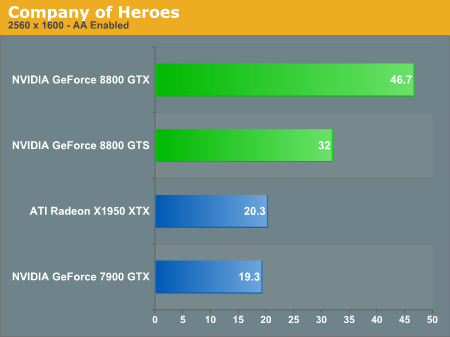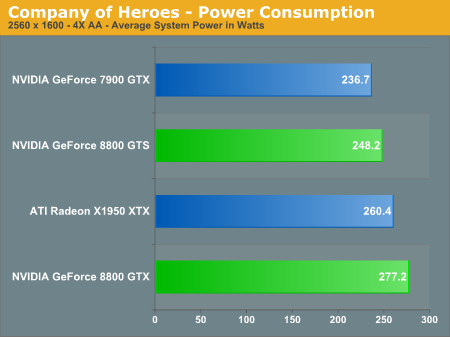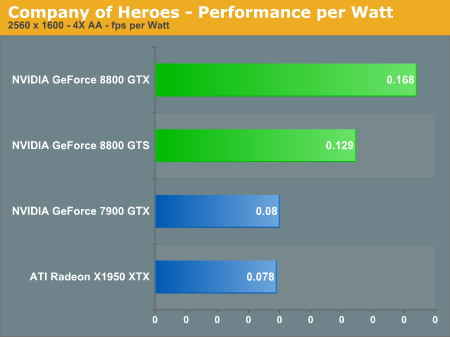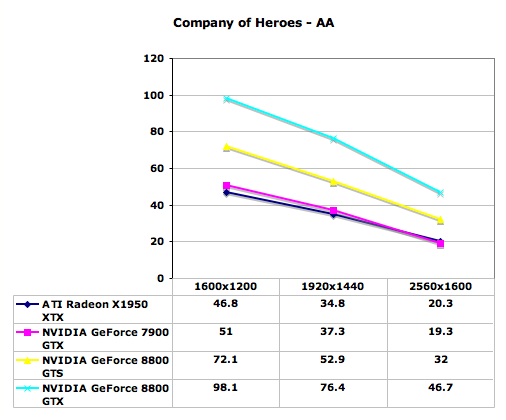NVIDIA's GeForce 8800 (G80): GPUs Re-architected for DirectX 10
by Anand Lal Shimpi & Derek Wilson on November 8, 2006 6:01 PM EST- Posted in
- GPUs
We're going to dispense with a lot of the introductory commentary for all of our gaming benchmarks, as we already have a ton of material to present. At this point, most of you are already familiar with what benchmarks we use and how they are run. If not, you should easily be able to find the information in a previous article. So, rather than adding hundreds of words of repeat text, we're just going to cut straight to the chase and talk about performance.
Company of Heroes Performance




Starting with Company of Heroes, we have a game that really stresses the graphics card at higher settings, though in the past we've also shown that it tends to be CPU limited with different detail settings. Running maximum details, all of the cards still managed to deliver acceptable gameplay at 1600x1200 or lower resolutions. 1920x1440 is still playable as well, but if you have a 30 inch LCD running 2560x1600 and you want to run with antialiasing, you're really going to need a GeForce 8800 series card. The GeForce 8800 is clearly more powerful than anything ATI currently offers, which is to be expected as it's a next-generation card competing with current generation hardware. What's impressive is that the 8800 GTX is basically as fast running 2560x1600 as the GeForce 7900 GTX or Radeon X1950 XTX running at 1600x1200. Put another way, a single 8800 GTX is over twice as fast as a single X1950 XTX in all of the tested resolutions, and it's also about twice as fast as a 7900 GTX.
As far as multiple graphics card configurations go, Company of Heroes currently did not show any performance improvements. Most likely that means that NVIDIA and ATI drivers have not been properly optimized for this game at present. This is a problem that occurs periodically with new titles, and it's always frustrating to get a new game only to find out that it isn't properly using your hardware -- especially if you've shelled out the money for dual graphics cards. This is why we have repeatedly recommended in the past that you purchase a faster single graphics card rather than moving to dual GPUs, up to the point where you basically have the fastest single graphics card available. GeForce 8800 GTX now holds the title of fastest single GPU, so if you were previously looking to spend $800 on a couple of GPUs, you should seriously consider a single 8800 GTX instead. The DirectX 10 support is merely icing on the cake.










111 Comments
View All Comments
yyrkoon - Thursday, November 9, 2006 - link
If you're using Firefox, get, and install the extension "flashblock". Just did this myself today, tired of all the *animated* adds bothering me while reading articles.Sorry AT guys, but we've had this discussion before, and its realy annoying.
JarredWalton - Thursday, November 9, 2006 - link
Do you want to be able for us to continue as a site? Because ads support us. Anyway, his problem is related to not seeing images, so your comment about blocking ads via flashblock is completely off topic.yyrkoon - Thursday, November 9, 2006 - link
Of course I want you guys to continue on as a site, just wish it were possible without annoying flashing adds in a section where I'm trying to concentrate on the article.As for the off topic part, yeah, my bad, I mis-read the full post (bad habit). Feel free to edit or remove that post of mine :)
archcommus - Thursday, November 9, 2006 - link
What browser are you using?falc0ne - Thursday, November 9, 2006 - link
firefox 2.0JarredWalton - Thursday, November 9, 2006 - link
If Firefox, I know there's an option to block images not on the originating website. In this case, images come from image.anandtech.com while the article is on www.anandtech.com, so that my be the cause of your problems. IE7 and other browsers might have something similar, though I haven't ever looked. Other than that, perhaps some firewall or ad blocking software is to blame - it might be getting false positives?archcommus - Thursday, November 9, 2006 - link
Wow to Anandtech - another amazing, incredibly in-depth article. It is so obvious this site is run by dedicated professionals who have degrees in these fields versus most other review sites where the authors just take pictures of the product and run some benches. Articles like this keep the AT reader base very very strong.Also wow to the G80, obviously an amazing card. My question, is 450W the PSU requirement for the GTX only or for both the GTX and GTS? I ask because I currently have a 400W PSU and am wondering if it will be sufficient for next-gen DX10 class hardware, and I know I would not be buying the highest model card. I also only have one HDD and one optical drive in my system.
Yet another wow goes out to the R&D monetary investment - $475 million! It's amazing that that amount is even acceptable to nVidia, I can't believe the sales of such a high end, enthusiast-targeted card are great enough to warrant that.
JarredWalton - Thursday, November 9, 2006 - link
Sales of the lower end parts which will be based off G80 are what make it worthwhile, I would guess. As for PSU, I think that 450W is for the GTX, and more is probably a safe bet (550W would be in line with a high-end system these days, although 400W ought to suffice if it's a good quality 400W). You can see that the GTX tops out at just under 300W average system power draw with an X6800, so if you use an E6600 and don't overclock, a decent 400W ought to work. The GTX tops out around 260W average with the X6800, so theoretically even a decent 350W will work fine. Just remember to upgrade the PSU if you ever add other components.photoguy99 - Thursday, November 9, 2006 - link
I just wanted to second that thought -AT articles have incredible quality and depth at this point - you guys are doing great work.
It's actually getting embarrasing for some of your competing sites, I browsed the Tom's article and it had so much fluff and retread I had to stop.
Please don't forget the effort is noticed and appreciated.
shabby - Wednesday, November 8, 2006 - link
It wasnt mentioned in the review, but whats the purpose of the 2nd sli connector?